Rare blood disorders are health problems that affect the blood, which is a vital part of our bodies. Blood carries oxygen, fights germs, and helps heal cuts, so when something goes wrong with it, it can cause serious challenges. These rare conditions don’t happen to a lot of people, but for those who do have them, they can cause pain, illness, and even life-threatening situations.
That’s why it’s important for doctors and scientists to study these disorders closely. Many of them are caused by tiny changes, or “mistakes,” in our genes—the instructions that tell our bodies how to work. By studying these genetic causes, scientists can figure out how these disorders happen, how to find them early, and how to treat them better. Understanding the link between genes and blood disorders gives us hope for better care and even potential cures in the future.
What Are Genes and How Can They Cause Problems?
Genes are like tiny instructions inside your body. They tell your body how to work and how to grow. You get your genes from your parents, and they are part of your DNA, which is in every cell of your body. Genes decide things like the color of your eyes, your height, and even how your blood is made. But sometimes, genes can have mistakes in them. These mistakes are called mutations.
When a gene has a mutation, it might not work the right way. This can cause problems in your body, including rare blood disorders. For example, hemophilia is a blood disorder caused by a mutation in certain genes (called F8 or F9). These genes help your blood clot when you get a cut or wound. If they don’t work right, you could bleed too much, even from a small injury.
Another example is sickle cell anemia. This happens because of a mutation in a gene called HBB. This gene helps make red blood cells, which are normally round and soft. But in people with sickle cell anemia, the red blood cells are shaped like a crescent moon or a sickle. These sickle-shaped cells can get stuck in blood vessels, causing pain and not carrying oxygen as well as they should.
How Do Doctors Find Rare Blood Disorders?
Sometimes, it’s hard to figure out if someone has a rare blood disorder just by looking at their symptoms. That’s where genetic testing comes in. Genetic testing is like a special detective tool for doctors. It lets them look at your DNA to find out if there are any gene mutations.
This testing is super helpful. For example, when babies are born, doctors can test them for certain conditions like sickle cell anemia. If a baby has the disorder, doctors and parents can start taking care of it right away.
Genetic testing can also help families who might carry certain gene mutations. If you know you have a gene for something like hemophilia or sickle cell disease, you can plan ahead. Some families use this information to decide what’s best for having children or choosing medical care.
What Are Scientists Doing to Help?
Scientists have been working hard to find new ways to help people with rare blood disorders. One amazing thing they are studying is called gene editing. This is where they "fix" or change the faulty gene so it starts working properly. A tool called CRISPR is making this possible, and they are testing it right now to see if it can help diseases like sickle cell anemia.
Another big idea is gene therapy. This is where doctors give people a new, healthy gene to replace the broken one. Imagine if someone with hemophilia could get a working F8 or F9 gene! They might not need as many treatments to help their blood clot, which could make life much easier for them.
There are also new medicines and treatments being tested. For example, scientists are learning how to use a medicine called hydroxyurea to help some people with sickle cell anemia have fewer painful episodes.
What’s Next?
Learning about the genes behind rare blood disorders is helping doctors and scientists change lives. They’re not just treating symptoms anymore—they’re working towards fixing the actual problems in the genes.
Of course, there’s still a long way to go. Things like genetic testing and advanced treatments can be expensive, so not everyone can afford them yet. But as technology gets better and more people learn about these breakthroughs, it’s likely that more lives will be improved.
For now, scientists, doctors, and patients are working together to make rare blood disorders easier to understand and treat. Every discovery brings new hope for people with these conditions and their families. By studying genes, the tiniest part of our bodies, the world of medicine is making some of its biggest changes yet.
 (Image via
(Image via





